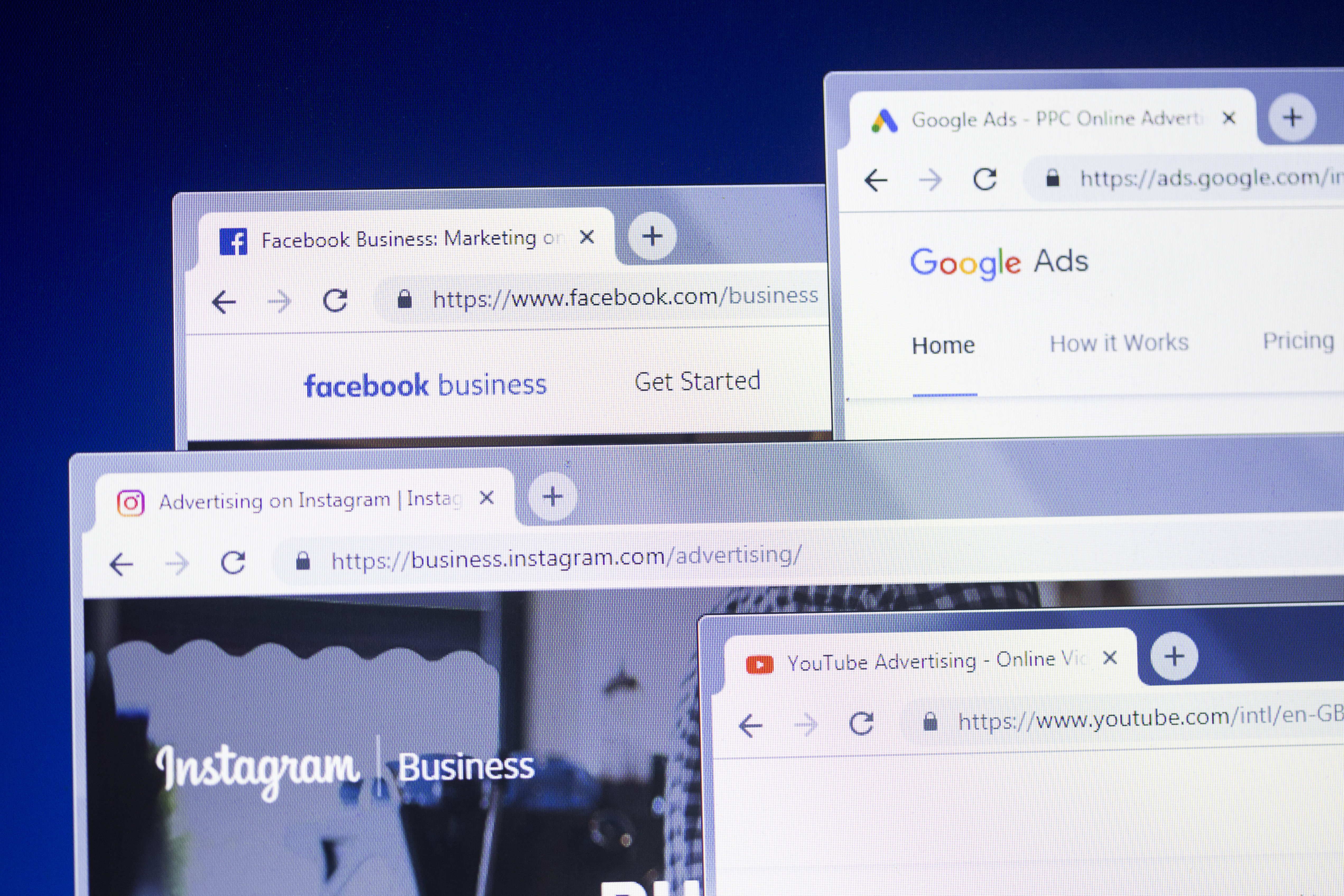


Everything you wanted to know about social ads, but were too afraid to ask

Social media advertising has proven to be one of the most effective ways for brands and businesses to reach their customers and, perhaps more importantly, find new ones. In fact, more than 70% of businesses say they have acquired new customers via social media. So, if you’ve never dipped your toe into the waters of social advertising, it’s time to start!
However, with more than $58 billion spent on social media advertising last year if you’re going to do it, it’s more important than ever that you make sure you’re doing it right. It’s no longer just a case of chucking £500 at Facebook and hoping for the best.
Fortunately, we’re here to help you. This guide aims to give you a brief overview of the various platforms, ad formats and strategies at your disposal to help you get started with your social campaigns.
Do I really have to pay?
Years ago, brands could rely on their posts reaching a significant number of their followers without having to worry about paying. Sure, it was still trickier to reach new fans, but they could be rest assured that their current following would see their content. Then, the ‘reachpocyalpse’ happened.
Essentially, this was when the social platforms woke up and realised that there was money to be made from all these brands posting on their platforms. All of a sudden, algorithms were adjusted and suddenly, the organic reach of a business’ post was negligible. Most studies say to expect no more than 2% organic reach, while Facebook themselves say to expect 0%. So, even with the best content in the world, if you want your brand to be seen on social, you’ll have to pay.
Ok, you’ve convinced me. Which channels are the best?
Let’s start with a figure. 2.8 billion. That’s how many users are currently active on Facebook. So, if you’re trying to spread your brand message, that’s not a bad place to start. Also, with all those people using their platform, Facebook – and Instagram, which shares the same advertising platform – offers the richest and most in depth targeting options. Also, because of the volume of people using the two channels, it tends to yield cheaper results than many of the other channels.
But, that doesn’t mean it’s cut and dry. You need to think about your audience and the context you want them to encounter your brand. Take LinkedIn for example. The sheer weight of employment-specific targeting options make this a really strong B2B option. Since Microsoft purchased LinkedIn, they’ve been working hard on their ads offering and there’s a lot of new formats available now. In fact, if you used LinkedIn a few years back, you’d probably be very pleasantly surprised today. However, it does tend to be a bit pricier to run as a channel. Why? Well, think about why you’re advertising on LinkedIn? Generally, you want to reach the decision makers. People of a certain level. C-Suite perhaps? Well yeah, you and everyone else. So go figure.
That brings us to Twitter. This is typically a trickier platform for advertisers, despite what Twitter would have you believe. With an average of 500 MILLION tweets sent per day, there’s just too much noise to cut through. Added to that, the ad formats aren’t as varied and versatile as other channels.
Having said that, it can be great for some really tactical campaigns. Jumping on something that’s trending. It’s the channel that people go to to follow things as they unfold. It’s also great for second-screening. Take Love Island for example. People would be watching the show and following reactions on Twitter. So syncing your advertising to moments like that on Twitter can really pay off. And Twitter knows this. That’s why to that end, it has some really good TV and live event targeting options. Live sports events are another great example of when you might want to run your ads.
Snapchat took a hit 18 months or so ago. An update that wasn’t well received, along with Instagram aping their stories feature, saw users leave the platform. However, advertisers who have stuck with it say results in 2019 have been very encouraging. So, if your audience is the type to use Snapchat, it’s definitely worth exploring the geofilters, display ads and video ad options that are available to advertisers.
Finally, the latest pretender to the throne is TikTok, beloved social app of GenZ. They’ve opened up their advertising platform in the US and are very much one to watch.

Everyone’s on social. How do I make sure my adverts reach the right people?
This is where social really excels. When you think of something like Google search ads, they’re exactly what they sound like. Adverts that target people already searching for something. With social advertising, the targeting options make it easier to reach people who didn’t necessarily know they were interested in your brand/product, as well as those who are.
Whether we like it or not, almost everything we do online is tracked in some way. This means the social networks are able to build up a profile of what we like – what have we liked, what have we shared, what do we comment on, which sites do we visit. Everything comes together to build up a rich profile. We can then target users based on this information – so things like hobbies & interests, which sports teams they follow, which tv programmes they watch, their job title etc. Maybe they have an anniversary coming up? Or their pet goldfish just turned 2? You name it, they’ve got it (okay maybe not the goldfish bit).
We’ll call this type of audience, ‘interest targeting’. But there are some other, potentially more lucrative ways to reach people.
Contact Lists
your best customers are going to be your existing customers. They’re already familiar with and invested in your brand and are thus more likely to repeat a purchase or engage with your content. LinkedIn, Twitter and Facebook/Instagram all allow you to upload a database of contacts (it could be your mailing list, customers, lapsed customers, etc.), whose details they will then match to users on the platform. You can then target these users with your ads. Just make sure your source data has been collected in a way that’s GDPR compliant.
Remarketing
using tracking pixels (a small piece of code you place on your website) you can target previous visitors to your website with social media adverts. This is a great way to reach people who’ve already engaged with your brand, potentially yielding more results at a cheaper cost. It might be that you want to target people who visited your website in the past three months. Simple and effective enough. But you can also get a lot smarter by targeting specific URLs. So a user may have visited your website, added a product to their basket and visited the checkout page, but not visited the order confirmation page. Essentially, they’ve abandoned their basket. With remarketing you can target ads to just these users, perhaps combining with free shipping or 10% off to give them that extra nudge to complete their purchase.
Lookalikes
Lookalikes, or ‘matched audiences’ as they’re known on some platforms, are a brilliant way to find newer, equally lucrative audiences. You start with a source audience – perhaps your customer list or previous website visitors – and then ask the social networks to identify users that are most similar to those people. It does this based on a whole heap of factors, from content they’ve engaged with through to demographic information. But what you’re left with is a bunch of new people to target who are likely going to be super relevant. So, if my source audience of mailing list subscribers is 10,000 people a lookalike might find 450k people that very closely match them. It’s great if you’re launching a new product or expanding into new territories, because you might take your source audience which could be predominantly users in the UK and then ask Facebook or whichever platform to find similar users in the US.
How much will it cost me?
How long is a piece of string? Let’s start with the bad news. Ad spend on these channels is going up year on year. So as a rule, these channels are getting more expensive as other users and businesses enter the fray. That said you can establish a few key points which should help you work out a rough spend. Firstly, how big is your audience? A few million? It’s gonna cost more to reach more of them than say an audience of 10k. However, you might be focused just on brand awareness and want to reach those 10k people lots of times, so that could still cost a lot. Then, who are you trying to reach? As mentioned earlier, competition for your audience is going to drive auction costs up – another reason to be precise with your targeting and understand your audience. Then length of time – how long is your campaign running for? Typically, you’ll spend more on a two month campaign versus a two week campaign. This isn’t dissimilar to how Google Ads operates. The more generic your search term bids are, the more expensive they’ll be. But if you bid on longtail terms (more precise and longer keywords), the cheaper the cost will be.
All of these factors build up a strategy and a plan. But you don’t really give a s**t about that do you? I can hear you screaming “just give me a figure”. Well, I used to say £25 a day was my minimum generally, but now it’s closer to £50. But certain campaigns are cheaper. For example, an awareness campaign where you just want your content on people’s feeds is going be cheaper to run than one where you want users to carry out an action, as those people are more sought after and competition is fiercer. Then there’s things like remarketing – these people are already familiar with your brand, so you’ll need to spend less to reach or convert them.
We touched on campaign length above and that’s important to consider. Often, you’ll have the choice of a lifetime budget or a daily budget. With a lifetime budget you set a total, let’s say £2,500 and let the platforms spend it as they see fit. The risk here is that you might spend all your budget within five days of what you hoped was going to be a week-long campaign. Now, the platforms will do this because they think there was more chance of getting a result, so they shifted budget accordingly. With a daily budget, you set a limit per day and the platforms will not spend more than that. So, this option gives more control, but can yield fewer results.
What should my ads say, and how should they look?
First things first. Forget about the copy. Well, not quite. But research has shown that the image/creative on a social media advert is typically responsible for 75-90% of all results. So if your creative doesn’t resonate, forget it.
Generally, you’ll want to blend in with the channel you’re on. So a nice lifestyle image will deliver better results on Instagram than LinkedIn for example. There are other tricks too. Images with people tend to work better on Facebook. Avoid stock imagery, nobody wants to see that on their social feed. And none of the platforms like to see too much text in an image.
When it comes to video, algorithms are constantly changing, but for now we recommend keeping it between 15-30 seconds but being sure to get your brand name/logo in early.
Carousel adverts work especially well for promoting a range of products or trying to tell more of a story.
Speaking of stories, these are a big game changer and need to be a massive focus for 2020. They’re the new status updates and more people will be gravitating towards these. Getting these right is going to be crucial. There are two approaches to them – either go all out, or don’t, but don’t half-arse it. What we mean is, a really slick, beautifully produced branded story can be truly captivating and tell a brilliant story. Equally, matching the look and feel of the stories it’ll sit alongside – raw, shaky, minimal production values - will also help you fit in on the platform. BUT something in between isn’t going to cut it.
Great. I’ve done all that - how do I know if my campaigns are working?
You’re going to want to check in on your campaigns regularly to make sure they’re delivering. What you’ll be looking for will vary depending on your objective. So if you’re looking to raise awareness, you’ll want to make sure you’re reaching a decent number of people each day. If you’re after a conversion or some kind of action, you’ll want to see these coming in at a good rate, but not a cost per result that is above what your business can sustain.
If things aren’t working it could be for a number of reasons. If the ad frequency is too high that could mean your audience is too small, so maybe consider broadening this. Another thing to check might be your ad’s creative. Again if the frequency is quite high consider freshening things up every couple of weeks with new creative and messaging so people aren’t sick of seeing the same ad. Likewise, if the relevancy score (how often people are positively engaging with your ads) is low, test some new messaging or imagery to see if that improves things.
So, there you have it. You’re all set to start running your own social campaigns. This guide is really just the tip of the iceberg however, so if you’d like to understand more or would simply like some help getting your campaigns up and running, get in touch with our Campaigns Team.
Posted 1 October 2019 by Ben Waterhouse
Posted 1 October 2019 by Ben Waterhouse